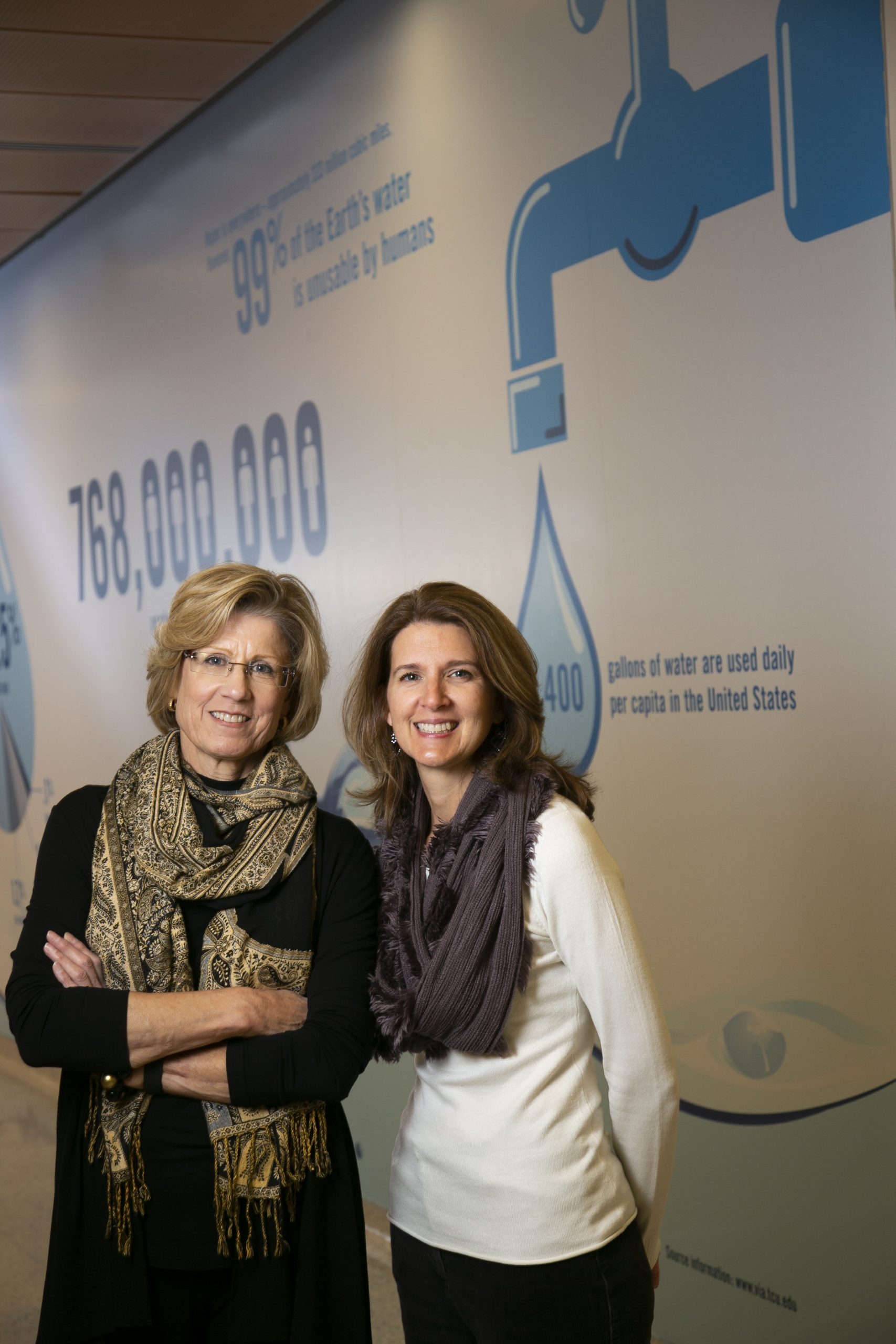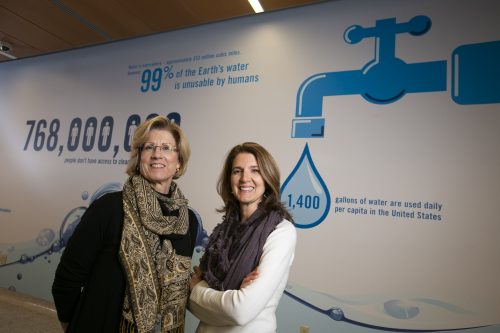March 24, 2020
Stopping a Disease Outbreak in its Tracks
TCU nursing students are learning to become medical detectives.

Sharon Canclini and Gina Alexander researched ways to simulate the health care response to an outbreak of waterborne disease. Photo by Rodger Mallison
March 24, 2020
Stopping a Disease Outbreak in its Tracks
TCU nursing students are learning to become medical detectives.
Water runs clear and clean through most taps in America, but safe drinking water remains elusive in much of the developing world. At least 2 billion people drink from contaminated water supplies.
Infection via unclean water is just one of many public health nursing issues senior-level students tackle during Gina Alexander and Sharon Canclini’s courses.
The professors’ ongoing research is about how creative pedagogy can prepare nurses to solve health problems before they turn into crises. Though most TCU nursing graduates go into acute care, prevention-minded public health skills could help nurses become investigators in any realm of the profession.

Sharon Canclini, assistant professor of professional practice, evaluated how effective a salutation was as an educational exercise. Photo by Rodger Mallison
“The idea,” said Canclini, assistant professor of professional practice, “is that if we can solve problems before [people] become critically ill, then let’s look at the problem from what we call the upstream approach.”
Health, after all, isn’t a strict function of an individual’s genetic constitution and behavioral choices. Environment matters a lot.
In 2017, Alexander and Canclini published an article in the Journal of Nursing Education about a simulation their students did to assess a fictional waterborne disease outbreak in the developing world.
The idea was inspired by a connection with civil engineer Jon Fripp, who has participated in almost 40 international trips to improve water safety, most of them as a volunteer for Engineers Without Borders.
Fripp and his son William, an RN, helped the professors develop a simulation using pictures they had taken of contaminated water systems in Afghanistan, Pakistan, Honduras, Guatemala, Nicaragua and Mexico. Students examined the photos for clues about why well water might contain harmful bacteria, such as an animal carcass near the water source.
To lead them into a detective’s mindset, Fripp suggested students might ask the local schoolteacher about how many children were regularly absent — a possible clue on the scope of the community’s public health problem. Another suggestion: Ask mothers how many children they had given birth to, versus how many living children they had.

Gina Alexander, associate professor of nursing, said collaborating is key to improving public health. Photo by Rodger Mallison
“For those who have not lived or traveled in impoverished areas, I think it was disturbing to them,” said Alexander, associate professor of nursing. She explained that many TCU nursing students had never stopped to consider that women their own age in poverty-stricken areas of the U.S. or low- and lower-income countries might have already lost children.
Students didn’t have time to travel to a remote village during the clinical, so professors collected water samples from a nearby creek. Even in well-developed and populated areas, water will often turn black to signify harmful bacteria when sampled by a test kit.
In teams of five or six, students used context clues to evaluate the infection-outbreak scenario and discuss how to address it.
The study’s intent was not to gauge a specific contaminated water threat or to tackle a global health problem, but to evaluate how effective the simulation of infection was as a pedagogical exercise.
“We have a certain gravitational pull to stay in our lanes, to only talk to people who have a similar background. And I think that we do a disservice by doing that.”
Jon Fripp
During the debrief after the simulation, Alexander and Canclini listened for clues as to whether they had altered the students’ thinking about the role of nursing professionals.
The students reported that they didn’t want to sit on the sidelines and watch a preventable health catastrophe unfold. Instead, they wanted to teach about solutions to the scenario — in this case water filtration, hygiene and protection of the water source.
The researchers also asked questions to measure changes in cultural humility, a key component of effective public health nursing.
Part of the lesson, Alexander said, is that nurses never work in a vacuum. If they want to improve public health, they need to build strong partnerships. “We want them to think about collaboration. We want them to think about involving as many community members as possible, so that [health] can be sustainable.”
Engineer Fripp agreed: “We have a certain gravitational pull to stay in our lanes, to only talk to people who have a similar background. And I think that we do a disservice by doing that.”
The crux of the pedagogy is to encourage students to consider the entire environment in treating and preventing disease, and then to recruit a team to improve health. The lessons matter, even to nurses who will go into acute-care work.

Sharon Canclini and Gina Alexander found encouraging students to consider the entire environment in treating and preventing disease matters. Photo by Rodger Mallison
And in Harris College, lessons are often of the boots-on-the-ground variety. Other recent student-led public health nursing projects have included a flu-shot clinic, a “Live Free” weekend promoting sobriety among college students, and construction of walking trails as safe routes to elementary schools. Environment is a health consideration for every segment of the world’s population.
“We want them to approach their care, [wherever] it may be, with that mindset of not taking everything at face value but trying to see maybe what other potential environmental or social determinants of health could be at play,” Alexander said.
One aspect of environmental-scope thinking is to acknowledge and address inequalities in health care, Alexander said, which exist not just around the world but also in the U.S. An inquisitive approach can enhance nurses’ clinical training and also allow them to grasp their potential as change agents.

Your comments are welcome
Comments
Related reading:
Features
Fellowship Program Trains Nurse Anesthetists to Treat Chronic Pain
The training focuses on alternative methods to help patients end their reliance on opioids.
Research + Discovery
What Does Dementia Feel Like?
Michelle Kimzey places empathy at the front of the nursing classroom to improve dementia care.
Features
New Fort Worth MD School’s Students Finish First Year
The first year in the lives of six students from the TCU and UNTHSC School of Medicine’s inaugural class was marked by innovation and pivots.